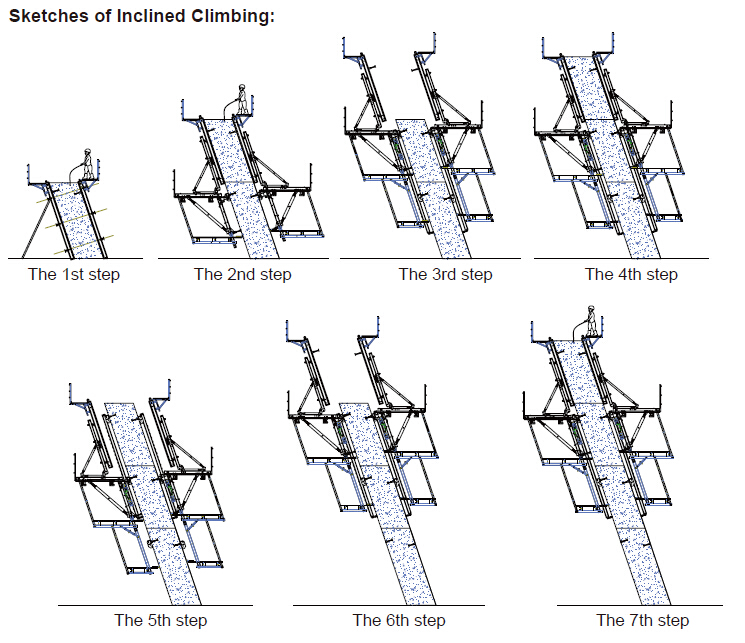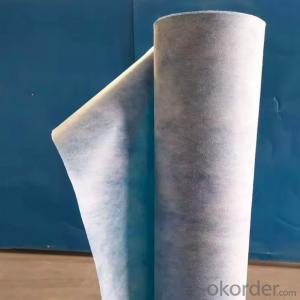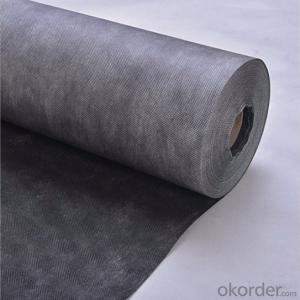Auto-climbing Bracket ACB100 & ACB50 for formwork and scaffolding system
- Loading Port:
- Tianjin
- Payment Terms:
- TT OR LC
- Min Order Qty:
- 50 m²
- Supply Capability:
- 1000 m²/month
OKorder Service Pledge
OKorder Financial Service
You Might Also Like
Auto-climbing Bracket ACB100 & ACB50
The power of the auto-climbing formwork is the hydraulic system, which includes the oil cylinder
and two commutators. The commutators can control the climbing of climbing rail and the bracket.
The steel rail and the bracket can inter-climbing, so the whole system will climb up steadily.
Cranes are not needed during the construction. It’s easy to operate, highly efficient and safe. It’s
the best choice for the construction of high buildings and bridges.
There are mainly two types of standard auto-climbing brackets, ACB-50 and ACB-100, the figure
means the push power of cylinder with unit of KN.
Characteristics:
◆ Perfect load bearing anchor system
Anchor system is the most important supporting part. The system is made of five parts shown
below. Thereinto, tensile bolt, V-climbing cone and washer can be taken out for reusing after the
concrete pouring finished.There are two kinds of anchor systems,A & B. A is matched with single
anchor shoe and B is matched with double anchor shoe.
◆ Crane-independent
Crane-independent forming, striking and climbing speeds up the work procedures on the
construction site and also makes them independent of each other. This means the planned
sequences can be maintained along with guaranteeing high productivity levels. The crane can
therefore be used for other tasks.
Hydraulic system is mainly made of two commutators,
oil cylinder and power distribution system.The
commutators can control the climbing of climbing rail
and bracket.
◆ High bearing capacity and safe
The stable working platforms are able to carry large loads, e.g. the storage of reinforcing steel
for the next climbing section. Generously-sized working platforms, the well thought-out design for
handling very high wind loads and the patented control function of the climbing mechanism are
some of the special details contained within the comprehensive safety concept.
◆ Platforms adjusted to suit the angle of inclination
The horizontal working areas thus created provide safe and comfortable conditions for
reinforcement work, shuttering and striking, concreting and finishing.
◆ The ACB formwork system can climb not only vertically but also slantways, the largest angle is
18 degrees.
◆ The system can climb up wholly or separately. The climbing process is steady, synchronous
and safe.
◆ The bracket will not fall to the ground until the construction is finished, the field will be saved
and the impacting breakage will be reduced (especially the panel).
◆ The system will furnish omnidirectional platform, the construction organizations don’t need to
set up additional operation platform.
◆ The error of structure construction is small and easy to correct.
◆ The climbing speed is fast, the construction course will be quickened.
◆ The formwork can climb itself and cleaning work can be done in the same situs , the used times
of tower crane will be greatly reduced.

- Q:What are the different types of joints used in steel formwork?
- There are several different types of joints commonly used in steel formwork for construction projects. These joints are designed to provide stability and ensure the proper alignment of the formwork system. 1. Butt Joint: The butt joint is the most basic type of joint used in steel formwork. It is formed by placing two formwork panels together, with their edges abutting each other. This joint is often reinforced with steel plates or angles to provide additional strength and stability. 2. Corner Joint: As the name suggests, corner joints are used to connect formwork panels at corners. These joints are typically reinforced with steel angles or brackets to ensure proper alignment and support. 3. T-Joint: T-joints are used in situations where formwork panels intersect at a perpendicular angle. This joint is formed by connecting three formwork panels together, with one panel positioned perpendicular to the other two. 4. L-Joint: L-joints are similar to T-joints, but they are used when formwork panels intersect at a 90-degree angle. This joint is formed by connecting two formwork panels together, with one panel positioned perpendicular to the other. 5. Lap Joint: Lap joints are used when long formwork panels need to be connected to create a continuous surface. This joint is formed by overlapping the edges of two panels and securing them together with bolts or clamps. 6. Hinged Joint: Hinged joints are used when formwork panels need to be adjustable or movable. This joint allows for flexibility in formwork placement and can be locked in various positions to accommodate different shapes and sizes. It is important to note that the specific type of joint used in steel formwork will depend on the requirements of the construction project, including the desired formwork system and the structural design. The selection of the appropriate joint is crucial to ensure the overall stability and strength of the formwork system.
- Q:Can steel formwork be used for high-rise construction projects?
- Yes, steel formwork can be used for high-rise construction projects. Steel formwork is known for its strength and durability, making it suitable for heavy-duty applications such as high-rise construction. It provides excellent stability and support to the concrete during the pouring and curing process, ensuring the structural integrity of the building. Additionally, steel formwork can be easily assembled and disassembled, making it efficient for use in tall structures where multiple floors need to be constructed. Its reusable nature also allows for cost savings in the long run. Overall, steel formwork is a reliable and popular choice for high-rise construction projects.
- Q:What are the different types of coatings used for steel formwork panels?
- There are several different types of coatings that can be used for steel formwork panels, depending on the specific requirements of the project. Some common types of coatings include: 1. Galvanized Coatings: Galvanizing is a popular coating method that involves applying a layer of zinc to the steel surface. This coating provides excellent corrosion resistance and durability, making it suitable for projects that require long-lasting and weather-resistant formwork panels. 2. Epoxy Coatings: Epoxy coatings are applied as a protective layer on the steel surface to enhance its resistance to corrosion, chemicals, and abrasion. These coatings are highly durable and can withstand harsh environmental conditions, making them ideal for formwork panels used in aggressive environments such as chemical plants or marine structures. 3. Powder Coatings: Powder coatings involve applying a dry powder to the steel surface, which is then cured under heat to create a protective layer. This coating offers excellent adhesion, durability, and resistance to corrosion, making it a popular choice for formwork panels used in both indoor and outdoor applications. 4. Paint Coatings: Paint coatings are commonly used for steel formwork panels due to their versatility and cost-effectiveness. These coatings provide a decorative finish while also offering some level of protection against corrosion and abrasion. However, they may not be as durable as other coating options and may require regular maintenance. 5. Plastic Coatings: Plastic coatings, such as polyethylene or polyvinyl chloride (PVC), can be applied to steel formwork panels to provide a protective layer against corrosion, chemicals, and abrasion. These coatings are often used in environments where chemical resistance is critical, such as wastewater treatment plants or industrial facilities. It is important to select the appropriate coating for steel formwork panels based on the specific project requirements, including the expected lifespan, environmental conditions, and desired level of protection. Consulting with a coating specialist or manufacturer can help determine the best coating option for a particular application.
- Q:How does steel formwork contribute to the construction process?
- Steel formwork contributes to the construction process by providing a durable and reusable framework for concrete pouring. It ensures accurate shaping and alignment of the structure, allowing for efficient construction and reduced labor costs. Additionally, steel formwork offers increased strength and stability, enabling the creation of complex and high-rise structures with precision.
- Q:How does steel formwork affect the overall thermal insulation of a structure?
- Steel formwork does not have a direct impact on the thermal insulation of a structure as it is primarily used for shaping and supporting concrete during construction. The primary purpose of steel formwork is to provide structural stability and shape to the concrete elements of a building, such as walls, slabs, and columns. The overall thermal insulation of a structure is mainly determined by other factors such as the type and thickness of insulation materials used, the design of the building envelope, and the presence of thermal bridges. Insulation materials such as foam boards, fiberglass, or mineral wool are typically installed within the walls, floors, and roofs to limit heat transfer through conduction, convection, and radiation. While steel formwork itself does not contribute significantly to thermal insulation, it can indirectly affect the insulation of a structure through its impact on the construction process. For instance, if the steel formwork is not properly sealed or installed, it can create gaps or voids in the concrete, which may allow heat to escape or enter the building. Additionally, if the formwork is not aligned accurately, it can affect the placement of insulation materials, resulting in thermal bridging and reduced overall insulation effectiveness. It is crucial to ensure that proper insulation measures are taken during the construction process, regardless of the type of formwork used. This includes ensuring that insulation materials are correctly installed without any gaps or thermal bridges and that the formwork is properly sealed to prevent air leakage. By addressing these aspects, the thermal insulation of the structure can be effectively maintained, regardless of the presence of steel formwork.
- Q:Can steel formwork be used for underground construction projects?
- Yes, steel formwork can be used for underground construction projects. Steel is a durable and strong material that can withstand the pressure and conditions found in underground structures. It provides stability and support during the construction process and can be easily reused or recycled after the project is completed.
- Q:Can steel formwork be used for curved or non-standard concrete shapes?
- Indeed, curved or non-standard concrete shapes can be achieved using steel formwork. The versatility of steel as a material allows for its effortless manipulation into various forms. This quality makes it particularly suitable for creating concrete structures with unique and intricate designs. Unlike traditional wooden formwork, steel formwork can be easily bent, twisted, or shaped to accommodate any desired curvature or non-standard shape. Furthermore, steel formwork offers exceptional strength and durability, ensuring its ability to withstand the immense pressure exerted by the concrete during pouring and curing. Consequently, steel formwork is widely employed in construction projects necessitating curved or non-standard concrete shapes, including architectural features, decorative elements, and complex structural components.
- Q:How does steel formwork contribute to easier formwork removal?
- Steel formwork contributes to easier formwork removal in several ways. Firstly, steel formwork is known for its strength and durability, allowing it to withstand the pressure exerted by the poured concrete. This means that steel formwork is less likely to warp or deform during the curing process, resulting in a more stable structure and easier removal. Additionally, steel formwork is typically designed with smooth surfaces and tight joints, which prevents the concrete from sticking to the formwork. As a result, when it comes time to remove the formwork, the concrete can be easily separated from the steel surface, minimizing the risk of damage to the concrete and making the removal process quicker and more efficient. Furthermore, steel formwork often incorporates various release agents or coatings that further facilitate the easy removal of the formwork. These agents act as a barrier between the concrete and the steel, reducing adhesion and allowing for smooth separation. Overall, the use of steel formwork provides a reliable and efficient solution for formwork removal, ensuring that the process is easier, faster, and more cost-effective.
- Q:Can steel formwork be used for precast concrete facades with intricate patterns?
- Yes, steel formwork can be used for precast concrete facades with intricate patterns. Steel formwork is known for its strength and durability, making it suitable for creating complex and detailed designs. The flexibility of steel allows for the creation of intricate patterns, textures, and shapes on the surface of the concrete. Additionally, steel formwork can be easily adjusted and modified to accommodate any desired pattern or design. This makes it a popular choice for precast concrete facades that require intricate patterns or artistic elements. Overall, steel formwork provides the necessary support and versatility to achieve complex designs in precast concrete facades.
- Q:What is the expected lifespan of steel formwork ties?
- The expected lifespan of steel formwork ties can vary depending on several factors such as the quality of the steel used, the conditions in which they are used, and how well they are maintained. However, in general, steel formwork ties are designed to have a long lifespan and can often be reused multiple times. High-quality steel formwork ties that are properly maintained and used in appropriate conditions can last for several years. With regular cleaning, inspection, and maintenance, they can be reused for multiple construction projects, which helps to reduce costs and waste. However, it is important to note that steel formwork ties can deteriorate over time, especially if they are exposed to harsh environmental conditions or corrosive substances. Therefore, it is crucial to regularly inspect the ties for any signs of damage or corrosion and replace them if necessary. Additionally, proper storage and handling of the ties when not in use can also help extend their lifespan. In conclusion, while there is no fixed lifespan for steel formwork ties, with proper maintenance and care, they can last for several years and be reused multiple times, making them a cost-effective and sustainable option for construction projects.
1. Manufacturer Overview |
|
|---|---|
| Location | |
| Year Established | |
| Annual Output Value | |
| Main Markets | |
| Company Certifications | |
2. Manufacturer Certificates |
|
|---|---|
| a) Certification Name | |
| Range | |
| Reference | |
| Validity Period | |
3. Manufacturer Capability |
|
|---|---|
| a)Trade Capacity | |
| Nearest Port | |
| Export Percentage | |
| No.of Employees in Trade Department | |
| Language Spoken: | |
| b)Factory Information | |
| Factory Size: | |
| No. of Production Lines | |
| Contract Manufacturing | |
| Product Price Range | |
Send your message to us
Auto-climbing Bracket ACB100 & ACB50 for formwork and scaffolding system
- Loading Port:
- Tianjin
- Payment Terms:
- TT OR LC
- Min Order Qty:
- 50 m²
- Supply Capability:
- 1000 m²/month
OKorder Service Pledge
OKorder Financial Service
Similar products
New products
Hot products
Hot Searches

























